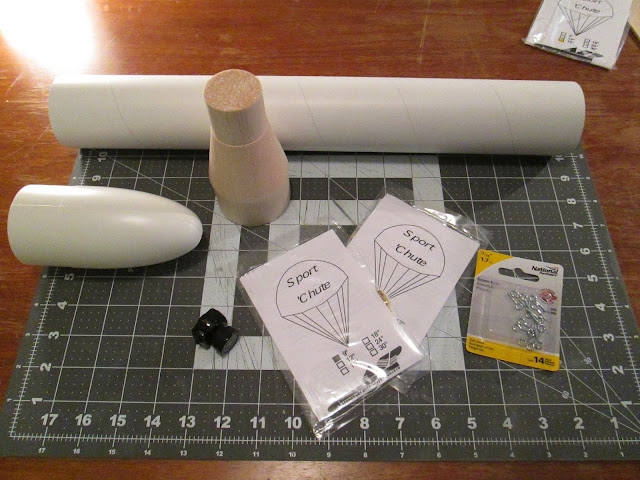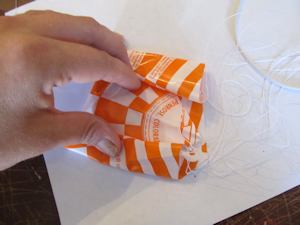If you're new to rockets, this might not mean anything to you, but stick with me. I'll explain.
So, Estes is not the only rocket company in the rocket biz. There are lots. One of them, Quest Aerospace (perhaps Estes' biggest rival in the low power rocket arena) is another. I have a few of their rockets, including the Magnum Sport Loader, a two-motor cluster rocket. Here's the video:
Quest has a line of motors and igniters. The igniters are called Q2G2, and they're sought after because they're very reliable - especially if you do cluster launches of low power, black powder motors (that's all I'm up to at this point). They require very low amperage to get them to fire, which means it takes less juice to get them to work quickly and properly - very important, since you want all your motors to ignite at the same time in a cluster rocket.
Problem is, Quest motors and starters have been out of stock for months - since long before I got involved in clusters. I kept hearing they'd be back in stock "in November," but, they're just not. Apogee Components has lately been saying "July 15."
I posted a thread on The Rocketry Forum to ask what the deal was. Were they ever coming back? Some insisted that, no, they are gone for good. Something to do with a recent merger between Quest and AeroTech (a company that specializes more in mid and high power rockets and motors). This Quest Q2G2 issue has been a hot topic in rocketry circles lately, and the thread has generated a lot of replies.
OK, that's Part One.
There's a guy named Bill Stine. He's basically been around hobby rocketry since the beginning, and he's the author - along with his father, the late G. Harry Stine (one of the founding members of model rocketry) - of The Handbook of Model Rocketry. If you're serious about pursuing rocketry as a hobby, and want to understand more about it, this book is required reading. I bought a copy for my Kindle and devoured it a few months back, and I turn back to it frequently. Seriously, get this book - it has a lot of information important to understanding rocketry basics. Point is, Bill Stine is one of the biggest names in hobby rocketry. He's like the Richard Leakey of model rockets.
Well, it appears as though Bill Stine himself responded to my thread.
Here's what he had to say:
Originally Posted by OldRocketeer"II"
OK, here's an official response from Quest:Wow, I thought, Bill Stine saw my TRF thread? He REPLIED to my thread? THE Bill Stine?? For real?? Am I reading this right???
First, NO, Q2G2 igniters are NOT gone forever and you will be able to purchase them again soon (both shorts and longs). The version that comes packed with the motors will not have any difference at all from the "originals" you guys love! But due to new pending BATF regulations, the ones sold as accessories are going to have a slightly different pyrogen on them - but you likely won't notice any difference.
And yes, we have been out of stock on A's, and then B's and then C6-5's. New production was completed in September and was expected to arrive via ocean freight then. Some regulations on shipping HazMat materials have recently changed in China - and we had to test new shipping cartons. Unexpected after unexpected delays just keep happening, and therefore I won't announce a "solid" arrival date now. but it will be soon...
We appreciate your patience and loyalty.
As to quality, the Quest China motors are very bit as reliable and safe as Estes BP motors (NAR MESS reports certainly support this). They are not made in a fireworks factory and the AQL process and testing is every bit as tough as it was in our own US factory years ago. In fact they are made from military grade BP - it just has a slightly slower burn rate than the US BP does. Most folks love our slightly slower burns, especially the C's. Teachers especially like the slower burn times because the kids get a bigger thrill out of slower boost that they can see...
The merger with AeroTech has been great, but of course there have been some "bumps". Running out of motors certainly was the biggest one...
We hope to have some new product announcements soon that I think the rocketry community will get a big buzz out of.
Bill Stine
I went to his profile page. Looks like he's been on TRF for almost six years, and though I may simply not be understanding what I'm seeing on the website... it looks like my post on TRF is the only one he's ever responded to.
And if that's actually true... it kind of blows my mind.
Anyway, whether or not Bill Stine wrote this post himself, or it's someone quoting Bill, it's good to know Quest will eventually put out new starters, because I want to build bigger clusters, and I want them to launch correctly.
And I choose to believe Bill Stine thought my post worthy of comment. Because... wow...
















































